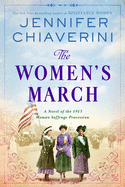
Set during the months leading up to and including the 1913 march for women's voting rights, Jennifer Chiaverini's historical novel is a colorful biography of three suffragists, and a reminder of history's relevance.
The courageous women's stories merge in Washington, D.C., on March 3, 1913, the day before anti-suffrage president-elect Woodrow Wilson's inauguration. Maud Malone, "militant suffragist librarian and notorious heckler," as a Wilson aide called her, arrives with the Army of the Hudson--53 women who publicized the march by hiking 250 miles from New York to attend. New Jersey Quaker and activist Alice Paul, leader of the movement for a constitutional amendment, proposed the march. As the event organizer, Paul faced southern white women demanding segregation of marchers, police refusing to control crowds and attacks by jeering, groping men along the route. Born into enslavement, journalist Ida B. Wells-Barnett fled Memphis when her newspaper was destroyed, settled in Chicago, co-founded the NAACP and became a respected writer and speaker. A member of the Illinois delegation to the march, Wells-Barnett persevered in representing women of color for suffrage. Along with the three women, nearly 5,000 marchers and tens of thousands of onlookers thronged to Pennsylvania Avenue. While hooligans tainted the glorious spectacle, citizen response worked in the suffragists' favor, drawing attention to the cause. They persisted, and Congress ratified the Nineteenth Amendment in August of 1920.
With voter suppression, racism and violent attacks on peaceful demonstrators appearing in this richly detailed novel, Chiaverini (Resistance Women; Enchantress of Numbers) strikes a timely chord in The Women's March. --Cheryl McKeon, Book House of Stuyvesant Plaza, Albany, NY

